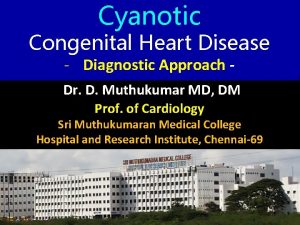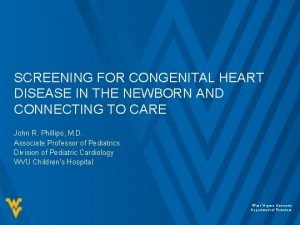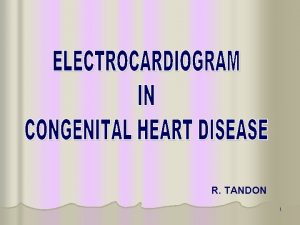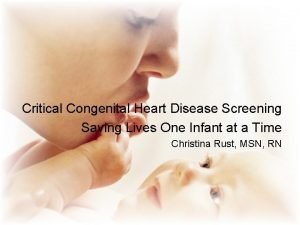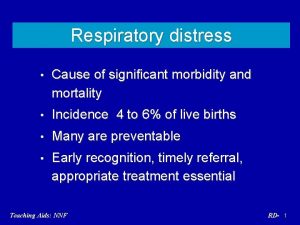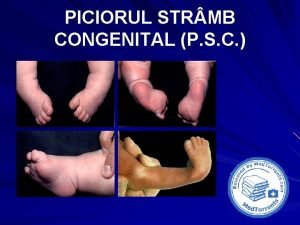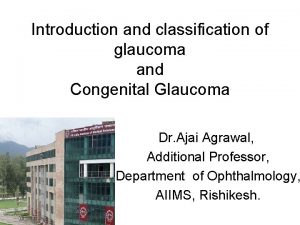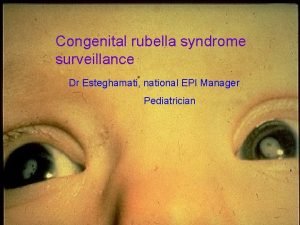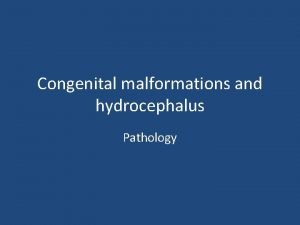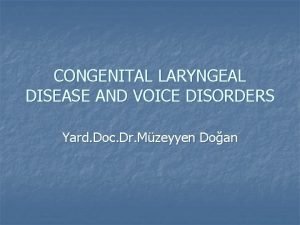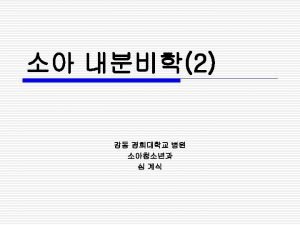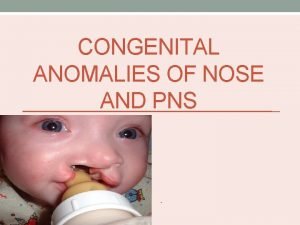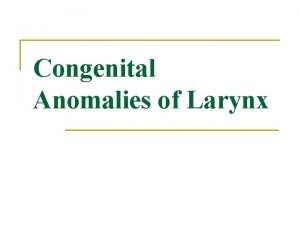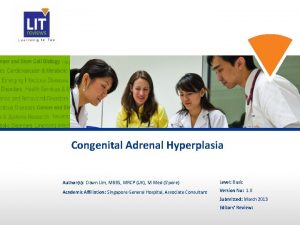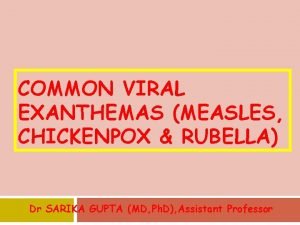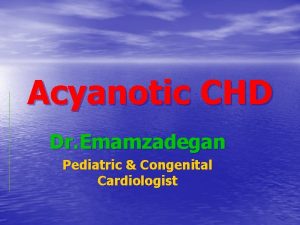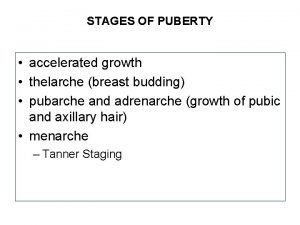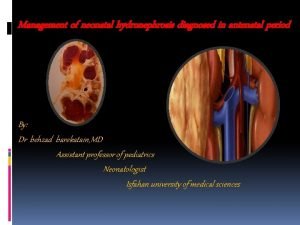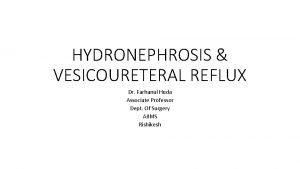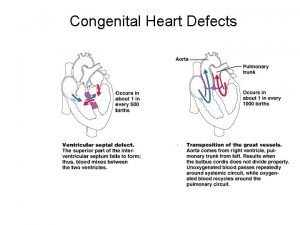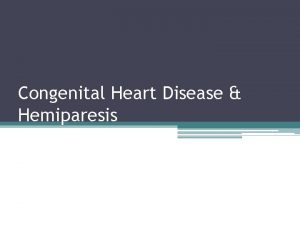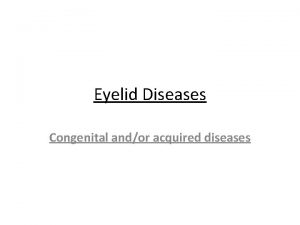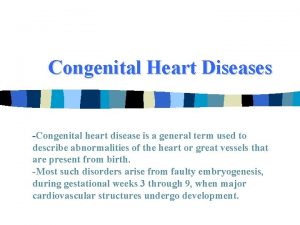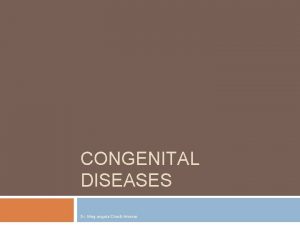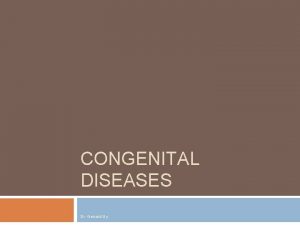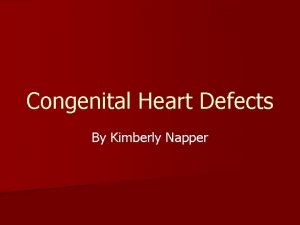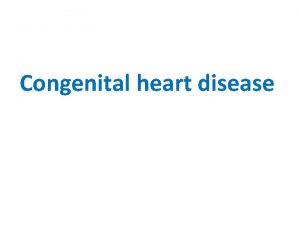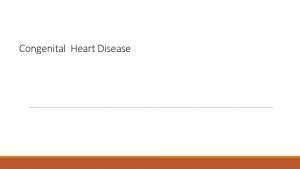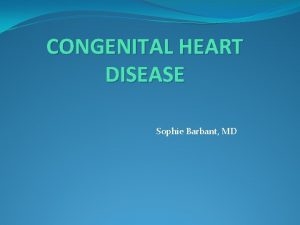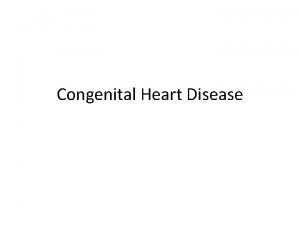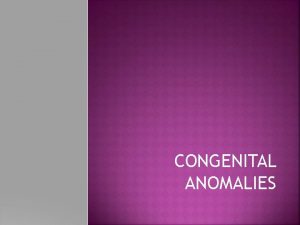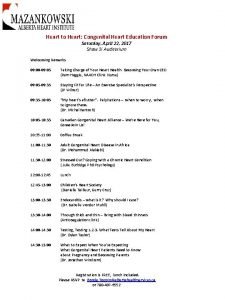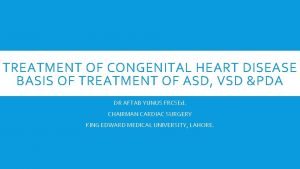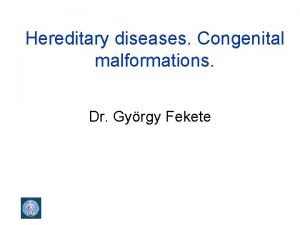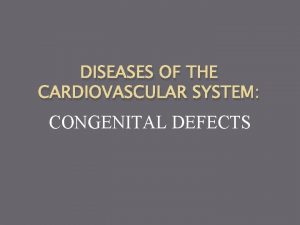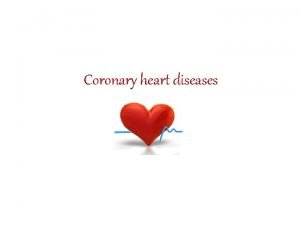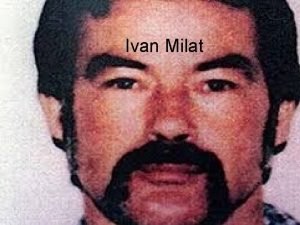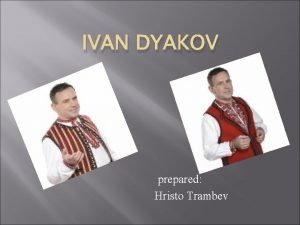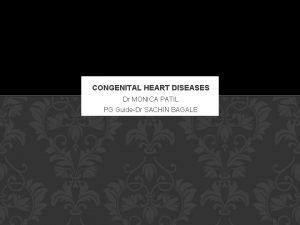Congenital heart diseases strategy for treatment Ivan Milev

























- Slides: 25

Congenital heart diseases - strategy for treatment Ivan Milev Special hospital for surgery, Filip Vtori, Skopje Macedonia Banja Luka, October 2008

Congenital heart diseases (CHD) § Definition § Epidemiology (0, 7 - 1, 7%) *Europian journal Epidemiology, 2007 § § Individual correction Precise diagnosis Оptimal treatment Мinimal invasive diagnostic method § Neonatal mortaliy rate 1971 2001 general neonatal mortality 1971 2001 CHD neonatal mortality

*Common CHD Types of CHD % of all Ventricular septal defect Patent ductus arteriosus Atrial septal defect Pulmonary valve stenosis Aortic coarctation Tetrady of Fallot Congenital aortic stenosis Transposition of the great vessels Atrioventricular canal *National data for health statistic in Republic of Macedonia, 2005 year 30. 0 9. 0 7. 5 7. 2 6. 2 5. 6 5. 2 4. 8 3. 9

CHD – the trends The facts § Noninvasive techniques (3 D echo, 64 -VCT) § Changes in pediatrics cath lab § Time, experience, training, OR in stand by

CHD- diagnostic procedures Frequent echo mistake § ASD venosus type § Aortic coarctation § Muscular VSD § PDA § T/PAPVD – venous confluens Diagnostic heart cath § § SV Т. Fallot with pulmonary atresia Pulmonary atresia without VSD Multiply VSD’s

CHD- surgical treatment Podelba: - palijativen - reparativen Specifi~nosti: -Mal bodi indeks anestezija ekstrakorporalna cirkulacija kardioplegija postoperativen monitoring

Tipovi na hirurgija (31. 12. 2007) N = 4533

Preдoperativна riзик stratifiкација N=138 pac • • • Возраст : 39. 5 11 god. Пол : 59 (42%) ma{ki /79 (58%) `enski NYHA class : III/IV Euroscore 26. 5% KAB 9 (6, 5%) PAH 45 (33%)pac so cijanoza 3 (2%) Reoperacii 2 (1%) Bubre`na insuficiencija 10 (7. 2%) Respiratorna insuficiencija 76 (55. 1%) E`екцона фракcија :

Kongenitalni zaboluvawa N= 138 pac. ASD tip II so trik rekon VSD so trikusp. rek. VSD so pro{ir. na RVOT 107 pac 48 pac 11 pac 6 pac 2 pac Can. atrioventr. 2 pac Pulm. stenosa 1 pac Ductus arteriosus 4 pac Coarctatio 3 pac Eissenmanager Sy 2 pac Mortalitet 2. 2% (3 pac) Dilativna cardiom. 2 pac Follow up 1 - 84 meseci Hypertrof. Cardiom. 1 pac.

Hirur{ka korekcija na VSD n =11 pac Hirur{ka korekcija na ASD n =107 pac ASD tip II so trik rekon Desna atrioplastika Plastika na pulmonalnite veni KAB So direktna sutura So perikarden pa~ VSD so trikusp. rek. VSD so pro{ir. na RVOT 48 pac 2 pac 9 pac 87 pac 20 pac 6 pac 2 pac

Hirur{ki pristap- minilateralna torakotomija n= 8 pac. so ASD Prednost: -mal cikatriks -rana mobilizacija -pomala bolna osetlivost

Sy Eissenmanager – case I va operacija: 07. 12. 2001 report 01/2005 dekompenzacija poradi nov Eho naod: sekundarna PAH (PA syst/med 110/65) MReg. +3, TReg +4, VSD, Pulm art. 42 mm Hirurgija: PA banding, Mitr. i tricuspidal rekonstrukcija. PA- 29 mm, PAsyst/med 68/43 II ra operacija: 05. 11. 2004 Eho naod: mitral reg. +4 (prolaps i dilatacija na anulusot), Trikuspidna reg. +3 Predop. PA syst/med 110/60, LAP 30 Hirurgija: MV zamena, Tricusp. rek, VSD zatvorawe so pa~ Postop. PAsyst/med 60/23 totalen AV blok 18. 02/2005 impantiran stalen pace maker 18. 08. 2007 PCT VSD zatvorawe Th: ACE inhibitori, spironolakton, diuretici, Sinkum Follow up 7 godini


Interventional procedures in Filip Vtori (2003 -2008) § 84 pt with CHD, 35 male / 52 female, age 3 months - 46 years *TTE was performed in all, TEE in 3, additional diagnostic heart catheterization in 14 pts

Amplatz septal ocluder, n= 36 Common CHD (7%) usually can be treated with interventional technique Surgical treatment is still standard, mortality rate < 1%, and residual shunt in 78% (long term follow up) Result between interventional vs surgical treatment are equal

ASD type sec - results and follow up § Average 3 mm underestimation of the size (TTE v. s angio) § 10 -30 mm ASD devices § In hospital stay 18± 4 hours § TEE during procedure in 3 pts § Without general anesthesia in all § ASA 10 mg/kg. TT/day during the next 6 months § 3 months endocarditis prophylaxis

Pulmonary valve stenosis n=23* § 7 % of all CHD § Тreatment of choice, PG >50 mm. Hg § BVP < RVSP and transpulmonary PG § Rare complications (PR) § Treatment in cyanotic CHD (paliative) § No efficiency in infundibulary PS, without valve stenosis § * 2 pts with TF

BVP of the PS - results and follow up § Average reduction of SPG 34 ± 9 mm. Hg § Seven (7) were treated with beta blockers after procedure § One young women was surgically treated due to severe RVOT hypertrophy § PR < 1 grade in all § Long life endocarditis prophylaxis

PDA - coils and devices; n=17 § Nine (9 ) % of all CHD § Varies types of devices and catheters § Coils, simply and effective (d < 2. 5 mm) § Small residual shunts with spontaneous resolving § Rеsidual shunts (5%-10%)

PDA- results and follow up § 17/18 pts. were completely closed, without residual shunt after one day § Eleven (11) Amplatzer ocluders and 6 coils were implanted § In hospital stay 28 ± 4 hours § One boy referred for surgical treatment due to large PDA § Endocarditis prophylaxis 3 months

VSD- Amplatz perimembraneous ocluder § Five (5) pts with perimembraneous VSD § Age 5 -45 years § Child with Trisomy 21 and VSD § A-V loop § ECG without AV block in all § Amplatz perimembraneous ocluder 8 -14 mm

Aortic coarctation, n=5 § Balloon angioplasty, 4 pts § Stenting of aorta in one § reduction of PG of 30 ± 5 mm. Hg

Closure of paravalvular mitral leak-case report § female, 55 years, mitral disease, PAH, DM II, obesity, COPD, hypothireosis §October, 2005 MVR (mech) §May, 2007 valve thrombosis, pulmonary edema (urgent reoperation) §Postoperative paravalvular leak 3 degree § August 2007, closure of the leak with implantation of muscular VSD occluder, 8 mm

Summary § All pts with ASD, VSD were successfully treated, as well as 17/18 pts with PDA § The average reduction of PG in pts with PS and aortic coarctation was > 40%. § All pts were discharged from hospital next day, with mean in hospital stay of 28 ± 8 hours. § None early complications (embolisation, severe arrhythmia, bleeding, infection) § High grade of security, safety and efficiency § Minimal physical and mental stress for the pts/ superior vs open heart surgery

Summary, trends § New approaches and visions in different CHD § Develop of new devices and techniques § Importance of TTE, TEE (3 D), 64 CT in diagnostics and follow up § Hybrid - minimal invasive method; new perspective § Early neonatal urgent procedures, and early (in utero) transport of the newborns in referent pediatric center
 Eisenmenger syndrome
Eisenmenger syndrome Asd vs pulmonary stenosis murmur
Asd vs pulmonary stenosis murmur Tet spell
Tet spell Canadian congenital heart alliance
Canadian congenital heart alliance Congenital heart disease pda
Congenital heart disease pda Congenital heart
Congenital heart Congenital heart defect
Congenital heart defect Modern treatment of heart disease
Modern treatment of heart disease Congenital pneumonia
Congenital pneumonia Congenital pneumonia
Congenital pneumonia Codivila
Codivila Stumped corneal opacity
Stumped corneal opacity Congenital rubella syndrome
Congenital rubella syndrome Congenital malformations
Congenital malformations Congenital voice disorders
Congenital voice disorders Congenital hypothyroidism
Congenital hypothyroidism Congenital fibrosis of the extraocular muscles
Congenital fibrosis of the extraocular muscles Choanal atresia,
Choanal atresia, Larynx
Larynx Congenital adrenal hyperplasia electrolytes
Congenital adrenal hyperplasia electrolytes Congenital rubella syndrome triad
Congenital rubella syndrome triad Congenital cardiologist near me
Congenital cardiologist near me Congenital rubella syndrome triad
Congenital rubella syndrome triad Congenital adrenal hyperplasia characteristics
Congenital adrenal hyperplasia characteristics Potter face oligohydramnios
Potter face oligohydramnios Congenital hydronephrosis
Congenital hydronephrosis
